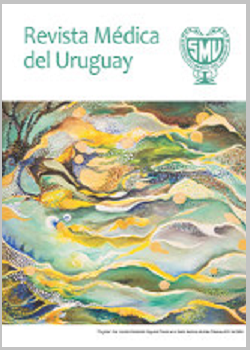Smoking in vehicles: measurement of 2.5 PM matter particles
Abstract
Introduction: Protection from second-hand smoke (SHS) is one of the main principles of the World Health Organization Framework Convention for Tobacco Control. Limited data is available on SHS exposure in vehicles in South America. This study aimed to assess the levels of exposure.
Methods: Levels of respirable and fine suspended particles with 2.5 micrometres or less (PM2.5) diameter were measured in different models in smokers’ and non-smoker´s vehicles.
Results: Median PM2.5 concentration was 181 µg/m3 in “smoking vehicles” and 0 µg/m3 in “non-smoking vehicles” (p<0.001). The highest concentration reached 2.900 µg/m3 in a parked car with the driver’s window partially open.
Conclusions: Concentration of PM2.5 in vehicles reached high levels, similar to those at certain sites in countries with weak tobacco control policies. These facts underscore a need for new public policies to eliminate SHS in vehicles to protect public health.
References
(1) World Health Organization. WHO report on the global tobacco epidemic, 2013: enforcing bans on tobacco advertising, promotion and sponsorship. Geneva: WHO, 2013.
(2) Eriksen M, Mackay J, Schluger N, Gomeshtapeh FI, Drope J. The tobacco atlas. 5th ed. Atlanta, GA: American Cancer Society, 2015.
(3) World Health Organization. WHO report on the global tobacco epidemic, 2008: the MPOWER package. Geneva: WHO, 2008.
(4) World Health Organization. Framework convention on tobacco control. Geneva: WHO, 2004.
(5) Abascal W, Esteves E, Goja B, González Mora F, Lorenzo A, Sica A, et al. Tobacco control campaign in Uruguay: a population-based trend analysis. Lancet 2012; 380(9853):1575-82.
(6) Uruguay. Instituto Nacional de Estadística. Encuesta continua de hogares. Montevideo: INE, 2014.
(7) Uruguay. Junta Nacional de Drogas. VI Encuesta nacional sobre consumo de drogas en estudiantes de enseñanza media. Montevideo: OUD-JND, 2014.
(8) Uruguay. Ministerio de Salud Pública. Carga de enfermedad atribuible al tabaquismo. Montevideo: MSP, 2014.
(9) Nerín I, Alayeto C, Córdoba R, López MJ, Nebot M. Measurement of fine breathable particles (PM2.5) as a marker of environmental smoke in catering establishments in Zaragoza. Arch Bronconeumol 2011; 47(4):190-4. [
(10) Comisión Honoraria de Lucha contra el Cáncer. Por la salud de nuestros niños y niñas: hogares libres de humo de tabaco. Montevideo: CHLCC, 2009: 33 p.
(11) The health consequences of involuntary exposure to tobacco smoke: a report of the Surgeon General. Atlanta, GA: CDC, 2006.
(12) Proyecto Internacional de Evaluación de Políticas de Control del Tabaco. Informe National ITC Uruguay: resultados de los relevamientos 1 a 4 de la encuesta (2006-2012). Montevideo: Universidad de Waterloo (Canadá), Centro de Investigación para la Epidemia del Tabaquismo, UdelaR, agosto 2014.
(13) Gendall P, Hoek J, Maubach N, Edwards R. Public support for more action on smoking. N Z Med J 2013; 126(1375):85-94.
(14) Llambi L, Barros M, Parodi P, Pippo A, Nuñez V, Colomar C, et al. Prevalence of invehicle smoking and secondhand smoke exposure in Uruguay. Tob Control 2018. doi: 10.1136/tobaccocontrol-2017-054092.
(15) Sendzik T, Fong GT, Travers MJ, Hyland A. An experimental investigation of tobacco smoke pollution in cars. Nicotine Tob Res 2009; 11(6):627-34.
(16) Hyland A, Travers MJ, Dresler C, Higbee C, Cummings KM. A 32-country comparison of tobacco smoke derived particle levels in indoor public places. Tob Control 2008; 17(3):159-65.
(17) Organización Mundial de la Salud. Guías de calidad del aire de la OMS relativas al material particulado, el ozono, el dióxido de nitrógeno y el dióxido de azufre: actualización mundial 2005. Ginebra: OMS, 2005: 21 p.
(18) World Health Organization. WHO guidelines for indoor air quality guidelines: selected pollutants. Copenhagen: WHO, 2010.
(19) Liu S, Zhu Y. A case study of exposure to ultrafine particles from secondhand tobacco smoke in an automobile. Indoor Air 2010; 20(5):412-23.
(20) Northcross AL, Trinh M, Kim J, Jones IA, Meyers MJ, Dempsey DD, et al. Particulate mass and polycyclic aromatic hydrocarbons exposure from secondhand smoke in the back seat of a vehicle. Tob Control 2014; 23(1):14-20.
(21) Raoof S, Agaku IT, Vardavas CI. A systematic review of secondhand smoke exposure in a car: attributable changes in atmospheric and biological markers. Chron Respir Dis 2015; 12:120-31. doi: 10.1177/1479972315575202.
(22) Semple S, Apsley A, Galea KS, MacCalman L, Friel B, Snelgrove V. Secondhand smoke in cars: assessing children's potential exposure during typical journey conditions. Tob Control 2012; 21(6):578-83. doi: 10.1136/tobaccocontrol-2011-050197.
(23) Jones IA, StHelen G, Meyers MJ, Dempsey DA, Havel C, Jacob P 3rd, et al. Biomarkers of secondhand smoke exposure in automobiles. Tob Control 2014; 23(1):51-7.
(24) Edwards R, Wilson N, Pierse N. Highly hazardous air quality associated with smoking in cars: New Zealand pilot study. N Z Med J 2006; 119(1244):U2294.
(25) Matt GE, Quintana PJ, Hovell MF, Chatfield D, Ma DS, Romero R, et al. Residual tobacco smoke pollution in used cars for sale: air, dust, and surfaces. Nicotine Tob Res 2008; 10:1467-75.
(26) Drehmer J, Walters B, Nabi-Burza E, Winickoff J. Guidance for the clinical management of thirdhand smoke exposure in the child health care setting. J Clin Outcomes Manag 2017; 24(12):551-9.













